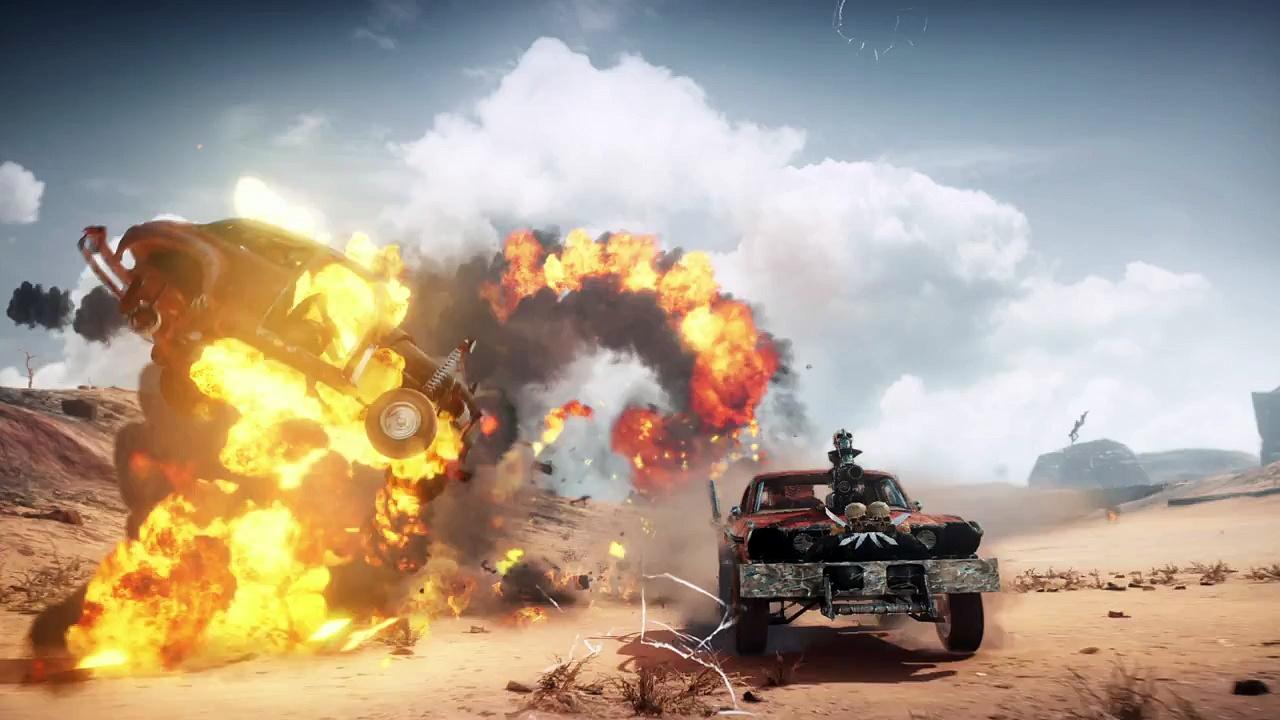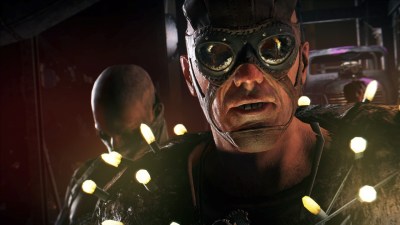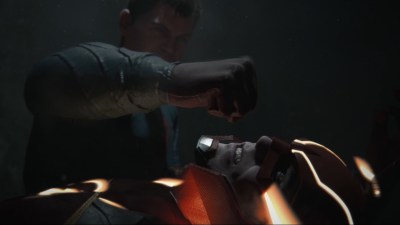As a symbol of the pure, unbridled anarchy that would be left in the wake of civilization’s collapse, George Miller’s Mad Max is pretty hard to beat. First introduced in the 1979 film of the same name, Max Rockatansky is a force of nature: a man who travels the post-apocalyptic Australian outback trying to survive in the wake of an undisclosed event that has reduced mankind to little more than scavengers.
Across three decades and four films, Mad Max has become an icon of post-apocalyptic sci-fi. While he rarely instigates it himself, Max’s exploits inevitably lead to chaos, destruction, and a high body count. Any good deed he commits is usually simply due to mutual convenience rather than any sense of duty to the vulnerable. There are just three constants in Max’s world: gasoline, bullets and anarchy.
It’s sad then that in Mad Max, from Just Cause developer Avalanche Studios, the character is reduced to little more than a courier - endlessly travelling back and forth across the vast open world running errands for the various characters he meets as he works towards getting his own back on the Warlord who wronged him.
Some of the characters he meets along the way initially seem interesting, but the paper-thin script never gives them room to develop into full-fledged personalities. Many of them are introduced only to be brushed aside and forgotten after a few missions, never to appear again; almost the entire cast feels disposable as a result, demoted to little more than talking heads to point you towards your next objective.
The sole exception is Chumbucket, who accompanies Max on his journey and believes him to be some kind of twisted messiah. His slavering devotion to Max starts to wear thin after a while, but you get the feeling that Chumbucket isn’t quite as mad as he first appears - he’s managed to survive in a world with nothing to hope for by inventing something to hope for, and Max gives him a reason for existing in the absence of anything else.
But beyond this, the story is a let down, and Max’s motivation for all the busywork he undertakes is about as thin as it gets. Mad Max’s narrative can be summarized in a single sentence: Someone stole Max’s car, and he wants it back. While there is some attempt at adding a little more substance to the story later into the game, the developments rarely convince - and by that point you’ll have spent around 30 hours of simply traipsing from one place to the next with no real narrative pull to keep you invested in the experience.
The main problem is the lack of agency. Things happen to Max, but rarely is he instigating events himself. Max never really questions all the busywork he’s sent on beyond the occasional complaint, and as a result the character feels neutered. While there‘s been plenty of destruction and a massive body count by the time the credits roll over the screen, none of it has felt meaningful.
This isn’t aided by the game’s structure, which falls squarely into the kind of cookie-cutter design template that will be familiar to anyone who’s played an open world game in the last few years - and particularly any open world game published by Ubisoft. The world is vast, but it’s populated by the same identical buildings and the same identical tasks, repeated ad infinitum. It’s the worst kind of open world bloat - tearing down endless sniper towers, clearing outposts of thugs, and uncovering areas by visiting the vantage points scattered around the map. You’ll gather scrap as you play, which is used as currency to afford new upgrades and build new structures at the strongholds you visit, but rarely does it feel as though there’s a reason for any of this to be present beyond the fact that it’s present in other (better) games.
Admittedly, there’s a class of player who will enjoy the process of ticking off another icon on the map and watching their task list gradually shrinking; but whereas in most
Vehicle combat is the best thing about the game. It’s just a shame that the rest of the experience feels so generic.
open world games these side activities are usually optional, providing players the freedom to simply blast through the story if they so desire, progress in Mad Max is repeatedly gated behind the need to complete a number of side activities in any given area before the next story mission will unlock.
If Mad Max‘s world was varied and full of interesting locations, there would be at least some sense of progression and reward for all of this. To its credit, Avalanche has made some effort to attempt to infuse each region with its own unique personality - not an insignificant task when you’re essentially faced with spending the entirety of the game in a desert. The starting area is largely indistinguishable from any other post-apocalyptic open world game you’ve ever seen, but later regions are defined by crags and canyons, swamps filled with oil, and a vision of an industrial wasteland that could have come from the nightmares of a Greenpeace activist.
Specific areas also show imagination. An airport buried beneath the sand provides a sudden shift in atmosphere and manages to feel suitably foreboding; Gas Town, the home of the game’s main villain, is faithful to its depiction in the films - a mess of fire, garbage and neon signs. It’s just a shame that Mad Max‘s gameplay never deviates from the same narrow formula. Story missions rarely stray from the simple routing of visiting a location, exploring it, and fighting off waves of enemies in an enclosed space. Even when the location itself impresses, the imagination shown in the visual design never extends beyond window dressing.
Speaking of fighting, influence has clearly been taken from Rocksteady’s Arkham series and the likes of Shadow of Mordor. There’s a single button for punching, and incoming blows can be countered when an icon flashes above the head of an opponent. You can also use Max’s trusty shotgun and pick up melee weapons, though ammo is scarce and weapons break easily.
The combat has none of the invention of the Arkham games’ gadgets, nor are there any stealth options or anything akin to Mordor‘s Nemesis system. As you level up Max you can unlock new moves, but the simplicity of the whole system means that you rarely feel as though you have much control over the on-screen action. Melee combat feels shallow - and with so much of it, and such little variety among the enemies you encounter, you’ll soon grow bored.
Thank God then for the vehicular combat, which is Mad Max‘s sole saving grace and just about manages to elevate the game into something a bit more enjoyable. Very early on, Max obtains the Magnum Opus - initially little more than a weak shell of a car, but which eventually becomes a road-dominating beast. Over time you’ll unlock more and more upgrades for the Magnum Opus, and increase both its offensive and defensive capabilities. Initially frustrating wheeled combat eventually becomes an empowering pleasure to indulge in as you fire its onboard hookshot at vehicles, literally tearing off their defenses, before driving up close to introduce the driver to the business end of Max’s shotgun, blowing up its gas tank, or simply ramming it off the road. A number of convoys can be found throughout the world, and once the Magnum Opus is sufficiently upgraded, taking them down becomes an irresistable diversion.
In fact, so good is the vehicular combat that it’s difficult to fathom just why Avalanche didn’t make it more of a focus, instead choosing to have players spend the majority of
their time instead indulging in the dull on foot sections.
At least the presentation impresses. Avalanche’s in-house engine is a tantalizing glimpse into what we can expect when Just Cause 3 lands in just a few short weeks. Explosions and smoke fill the screen, and the storms that regularly appear to wreak havoc show off the engine’s deft handling of dust and lighting effects. Character models and animation are also a highlight, bringing life to the many freaks who populate the wasteland.
Sound production is equally accomplished. For all the tedium that the shallow, repetitive combat brings, blows sound devastatingly brutal. Explosions sound like the end of the world. Upgrading the Magnum Opus not only makes the car look more threatening, but each engine brings with it an even more threatening roar, as though the car is the harbinger of a post-apocalypse apocalypse.
Unfortunately, the acting never really convinces, and isn’t helped by the thin script. Max himself is never really given room to shine, but his accent is at least authentic. But other characters are rarely elevated beyond basic sterotypes, and outside of cut scenes and the maniacal gibbering of your ever-present companion Chumbucket, dialogue is few and far between. Enemies sound little more than rabid dogs, growling and roaring as they come rushing at you with little incidental chatter that breathes life into the worlds of Arkham Knight and the Assassin’s Creed games.
Ultimately, Mad Max is competent, but forgettable. In a year filled with heavyweights like Arkham Knight and The Phantom Pain, it feels throwaway - something to maybe pick up if you find yourself somehow at a loose end for something new to play. The signs are there that Avalanche’s heart was in the right place, but it’s clear that the studio’s focus lay elsewhere and the result is a game that feels as though it isn’t sure what it wants to be, or recognizes its potential to be something far better.
In another world, one where Avalanche had the bravery to admit to itself that its focus was misplaced and that the gameplay lacked variety, Mad Max could have turned out to be something truly worthy of the license. Instead, we’re merely given a glimpse of what could have been - which only makes the rest of the experience that much harder to swallow.






